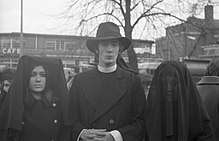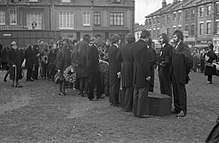Hornsey College of Art
Hornsey College of Art (a.k.a. Hornsey School of Art) is a former college centred on Crouch End in the London Borough of Haringey, England. The HCA was "an iconic British art institution, renowned for its experimental and progressive approach to art and design education".[1]
Background
The college was founded in 1880 as the Hornsey School of Arts by Charles Swinstead, an artist and teacher who lived at Crouch End, Hornsey. During the inter-war years the schools curriculum was composed of Fine Art, Advertising Design and Industrial Applied Art. It continued its day-time classes during World War II and was one of only two London art schools that did not vacate the capital during the blitz.
It became Hornsey College of Arts and Crafts in 1955. It survived until 1973 as a named entity, when it joined Enfield Technical College and Hendon Technical College to become Middlesex Polytechnic. The Polytechnic later became Middlesex University.
The 1968 sit-in
During 1968, the college was the scene of protests when students occupied the Crouch End Hill site.[2] Students attending the multi-site college convened to discuss the withdrawal of Student Union funds and resolved to sit-in. During this period they effected a temporary administration of the college, and called for major and consultative review of the art curriculum, supported by sympathetic academic staff and visiting artists. They offered a major critique of the education system at the time.[3] Some of these documents were presented as part of a project called The Hornsey Project. The college was repossessed by local authorities at the beginning of the summer break.
Hornsey achieved notoriety because of the scale of the all night protests and sit-ins, which were copied in similar art schools around the UK. During the six weeks that the sit-in lasted, Hornsey became the focus of debate about the method of art education and teaching in Britain. Hornsey was, and still is, afforded the blame for these disturbances that swept the student fraternity nationwide.
Kim Howells, a student and Nick Wright, then President of the Students' Union on a sabbatical year, initiated the sit-in. Howells later became a trade union official and a Minister in Tony Blair's government. After the protests, Tom Nairn, then a sociology lecturer, was dismissed from the college.[4]
"The Hornsey Affair", a book by students and staff at Hornsey, was published in 1969 by Penguin Books.[3] A documentary film, Our Live Experiment is Worth More Than 3,000 Textbooks, about the Hornsey sit-in was directed by John Goldschmidt for Granada Television and transmitted in 1969.
Patricia Holland's Hornsey Film 'reconstructs the arguments and succession of events that led to the occupation of Hornsey College of Art between May and July 1968'.[5]
Part of the Hornsey Archive is currently held at Middlesex University in the Sheppard Library as one of their special collections.


In April 1969 a follow-up mock funeral procession, performed by students of the art school, declared 'the death of Hornsey Hope'[6]
Recent use of the building
Middlesex University vacated the Crouch End building at an unknown time. The building was then used by the TUC as a training and conference centre. Since 2008, the building has been a part of Coleridge Primary School, upon its expansion to four-form entry.
Notable alumni and teachers
- Viv Albertine, musician[7]
- Martin Aynscomb-Harris, artist
- Mike Barson, musician
- Stuart Brisley, artist and teacher
- Neville Brody, typographer, art director and graphic designer
- Michael Casson, potter
- Michelle Cartlidge, writer and illustrator
- Wendy Dagworthy OBE, fashion designer and Royal College of Art professor[8]
- Joseph Darracott, art historian and writer
- Ray Davies, musician (Kinks)
- Lynsey de Paul, singer-songwriter
- Ted Dicks, composer
- Les Edwards, illustrator
- Edwin Embleton, graphic designer
- Robert Fuest, film director
- Roger Glover, musician
- Stuart Goddard (Adam Ant), musician
- James Herbert, novelist
- Adrian Hill, artist and broadcaster
- Ken Howard, artist
- Allen Jones, artist
- Anish Kapoor, artist
- Ken Kiff, artist
- Bryan Kneale, artist
- Bruce Lacey, performance artist
- Langlands and Bell, artists
- Dorothy Larcher, textile designer
- Roger Law, teacher, illustrator and co-creator of TV series "Spitting Image"
- Dante Leonelli, artist
- William McLellan, music video director and writer
- Tom Nairn, academic and writer
- John Napier, theatre designer
- Paul Neagu, sculptor, performance artist
- Sam Peffer, commercial artist
- Hallsteinn Sigurðsson, Icelandic sculptor and visual artist
- Norman Toynton artist
- Stanley Warren, art teacher, author of the Changi Murals as a Japanese prisoner of war
- Eric Watson, photographer
- Richard Wentworth, artist
- Richard Wilson, sculptor
- Theresa Wiseman, footballer and animator
- The Raincoats, rock band, members Gina Birch and Ana da Silva
References
- ↑ http://www.mdx.ac.uk/aboutus/Schools/art-and-design/index.aspx
- ↑ What happened at Hornsey in May 1968 — Nick Wright Archived 2011-10-06 at the Wayback Machine..
- 1 2 Various (1969). The Hornsey Affair. Penguin Education.
- ↑ http://www.newstatesman.com/society/2008/05/hornsey-college-1968-art
- ↑ "Watch The Hornsey Film - BFI Player". BFI Player. Retrieved 2018-05-30.
- ↑ Hornsey Weep-In Burial Service, performative play included in the Sheppard Library's Hornsey archive
- ↑ Clothes, Clothes, Clothes, Music, Music, Music, Boys, Boys, Boys; Viv Albertine; Faber & Faber 2014, p. 62
- ↑ Treneman, Ann (14 March 1998). "Profile: Wendy Dagworthy – Mentor a la mode". The Independent. Retrieved 6 April 2014.